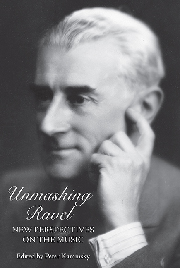Book contents
- Frontmatter
- Dedication
- Contents
- Acknowledgments
- Introduction
- Part One Orientations and Influences
- Part Two Analytical Case Studies
- 4 Ravel's Approach to Formal Process: Comparisons and Contexts
- 5 Repetition as Musical Motion in Ravel's Piano Writing
- 6 Playing with Models: Sonata Form in Ravel's String Quartet and Piano Trio
- 7 Spiral and Self-Destruction in Ravel's La valse
- 8 Diatonic Expansion and Chromatic Compression in Maurice Ravel's Sonate pour violon et violoncelle
- Part Three Interdisciplinary Perspectives
- List of Contributors
- Index
7 - Spiral and Self-Destruction in Ravel's La valse
from Part Two - Analytical Case Studies
Published online by Cambridge University Press: 05 September 2013
- Frontmatter
- Dedication
- Contents
- Acknowledgments
- Introduction
- Part One Orientations and Influences
- Part Two Analytical Case Studies
- 4 Ravel's Approach to Formal Process: Comparisons and Contexts
- 5 Repetition as Musical Motion in Ravel's Piano Writing
- 6 Playing with Models: Sonata Form in Ravel's String Quartet and Piano Trio
- 7 Spiral and Self-Destruction in Ravel's La valse
- 8 Diatonic Expansion and Chromatic Compression in Maurice Ravel's Sonate pour violon et violoncelle
- Part Three Interdisciplinary Perspectives
- List of Contributors
- Index
Summary
In La valse two aspects constitutive of Ravel's work converge in an ideal and characteristic manner: a tendency toward “distancing appropriation”—the ever-alienating incorporation of pre-found musical material into one's own musical language—and the formal conception of the “spiral,” with its acceleration and intensification toward a final culmination. The work is to a large extent choreographically shaped with tendencies toward caricature, the fateful, and the (self-)destructive to a degree that is singular in Ravel's oeuvre. This study will explore the aspects of distancing appropriation, spiral, and self-destruction.
Spiral Forms
Repetition, circular motion, and dance shaped Ravel's music at least since the Habanera (1895). These tendencies became integral to an unmistakable musical physiognomy as soon as Ravel succeeded in (1) making them serve in larger linear contexts; (2) differentiating the circular figures and functionally adjoining them to one another; and (3) developing formal conceptions that accommodated the choreographic orientation of the music. One of these formal conceptions, which I shall designate as the “spiral,” first appears primarily in finales: in the third movement of the Sonatine (1905), “Feria” (Rapsodie espagnole, 1907), “Scarbo” (Gaspard de la nuit, 1908), the “Danse guerrière” and “Danse générale” from both suites from Daphnis et Chloé (1912), and the “Toccata” from Le tombeau de Couperin (1917). All of these compositions combine a tendency toward periodicity with a prevailing escalating, teleological direction entailing all dimensions of the work.
- Type
- Chapter
- Information
- Unmasking RavelNew Perspectives on the Music, pp. 180 - 210Publisher: Boydell & BrewerPrint publication year: 2011

